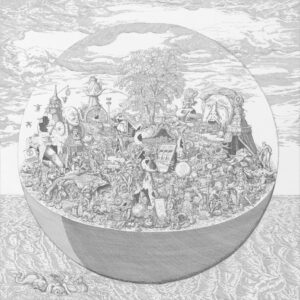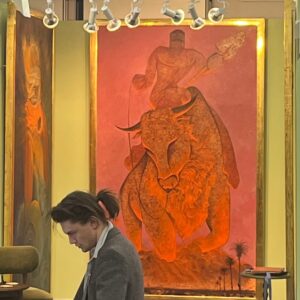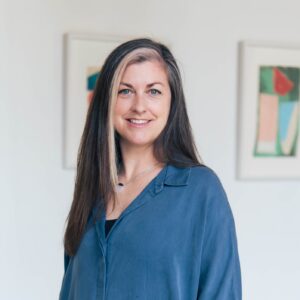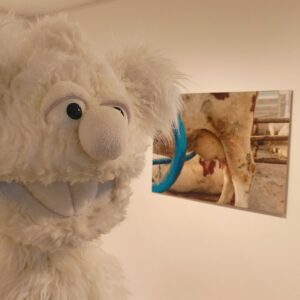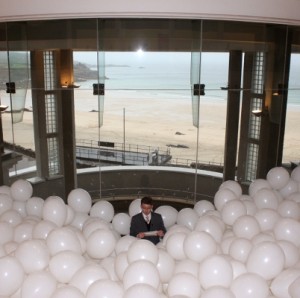 ‘Choirman (I am not him and I do not have your Pen)’, presented within Martin Creed’s ‘Work No.210 Half the air in a given space’, Tate St Ives, Solo Late at Tate Event, 24th June 2011. Photo: Miguel Amado.
‘Choirman (I am not him and I do not have your Pen)’, presented within Martin Creed’s ‘Work No.210 Half the air in a given space’, Tate St Ives, Solo Late at Tate Event, 24th June 2011. Photo: Miguel Amado.
Barry Sykes (b.1976) is a London-based artist. His conceptual and process-based practice crosses sculpture, photography, video, works on paper, writing, talks, sound and performance. Sykes’ work has been widely presented in the UK including Tate Modern, Limoncello and The Showroom (London); Spike Island (Bristol); Tate St Ives (Cornwall) and the Immersive Vision Theatre (Plymouth). His sound piece ‘THEN’ currently appears in the group exhibition ‘Leeds! Leeds! Leeds! at blip blip blip, Leeds. The show, curated by Hayley Dixon, brings together 24 audio works that have been made for and repurposed to be played in a 45 minute time period. It closes this Saturday 7 September 2013: www.blipblipblip.co.uk
‘Barry Sykes: It Must be Told’ is to be presented at Arnolfini (Bristol): part of the ‘4 Days’ festival which takes place between Thursday 12 September and Sunday 15 September 2013. A sequence of three performances staged as ‘The Preview’; ‘The Matinee’ and ‘End of the Run’ is a dramatisation of Sykes’ current research into a 1980s ghost play, utilising stage directions, borrowed props and Microsoft PowerPoint. For booking, and more information see: www.arnolfini.org.uk.
Sykes is currently an Artist in Residence at The University of Bath, working with The Institute of Contemporary Interdisciplinary Arts (ICIA). This residency runs through to June 2014: www.bath.ac.uk/icia/
Interview by Yvette Greslé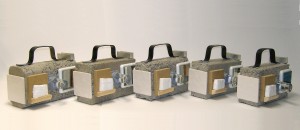 ‘Popular Problems (1-5)’, Mixed media, 2010.
‘Popular Problems (1-5)’, Mixed media, 2010.
Repetition seems to come up a lot in your work, and most recently in the performance planned for Arnolfini this month. What does repetition mean to you?
At the Arnolfini I’m essentially repeating the same talk (performance-lecture) three times. But I’m giving myself licence to do some quite hasty re-writes between each one. I do one on Thursday, one on Saturday afternoon, and one on Saturday evening – which I’m calling the Preview, the Matinee and the End of the Run. It’s like this micro-theatrical production where it goes from Preview to End of the Run in the space of two days. Hopefully they’ll be slightly different. I like the idea of talking about an idea and hearing myself say it for the first time. Then, it makes new sense to me. In this interview you’re hearing me express a thought for the first time. I’m hearing it for the first time too because I’ve never put it into these words before or in this sequence (or answered your questions before). I’m hoping that at Arnolfini, this kind of intensity of doing quite an elaborate talk (three times in a row in the one space, with a lot going on) will push my practice forward a lot. I consider this a method of research: I do it. I hear myself do it. I see the audience’s reaction to it. I think about it. I revise it. In-between each talk I’m going to adjust it, do some re-writes, chop it, put some new bits in. It will be impossible for me to do the talk in the same way again. I will have some control over it but also lack of control. It’ll be thrown over to human error and the stresses of a live performance. 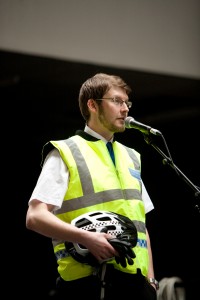 ‘Impersonating a Part-Time Police Community Support Officer’, Fabricated uniform, Q&A session, Tate Modern, 2010. Photo: Kevin Sykes.
‘Impersonating a Part-Time Police Community Support Officer’, Fabricated uniform, Q&A session, Tate Modern, 2010. Photo: Kevin Sykes.
Collaboration is an important part of your practice.
A lot of projects I’ve done in recent years have been something like a mixture of collaboration and conversation with people who have quite specific skill sets. Normally skill sets I don’t have or that are beyond the level of my own understanding. I did a project with my dad – ‘The Dad Directives’ (2008). I instructed him to take some photographs: he’s a very good photographer so it was really about me trying to understand him on that skill level. Happily, with him I did develop a conversational language. This project followed on to another one with a portrait photographer while I was on a residency in Plymouth.
This became the work ‘Portrait Session (Borrowed Instruments I cannot Play)’.
This was one of the commissions I did while on a residency with the Plymouth Arts Centre in 2010. I was still interested in working on a project with a photographer after ‘The Dad Directives’. I still had more questions about how photography functions. I had also met this portrait photographer in Plymouth – Eliot Siegel. I was fascinated by the reductive nature of a very specific genre of photography: black and white, close-up, cropped portraits of solo musicians. This is quite a narrow sub-genre of photography: where you get a photograph of a musician cradling an instrument that they are very good at (normally close to their face but they’re not playing it). They use it as a catch-all promo shot that they can give to anyone. It captures them and says (in a really reductive way): ‘I play this instrument so stick this in your brochure and people are going to get that I play this instrument really well’. I’m fascinated by how reductive this kind of image is about the (probably very immense) skill of these musicians. It also communes some kind of intimacy between this person and their instrument. It’s also a very utilitarian, easily reproducible image. I approached Eliot to take photographs of me also holding instruments. In the way, I hold them the photographs may communicate that I don’t know how to play any of them but, of course, there’s also lots of murkiness and ambiguity there. It’s saying a lot about the limits of what a photograph can communicate.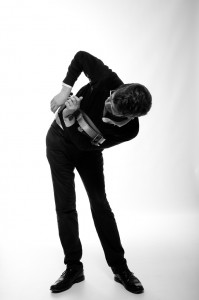 ‘Portrait Session (Borrowed Instruments I Cannot Play)’, 2010. Barry Sykes with Eliot Seigel.
‘Portrait Session (Borrowed Instruments I Cannot Play)’, 2010. Barry Sykes with Eliot Seigel.
Eliot was quite a high profile, international jet set photographer in the ’80s and ’90s doing lots of magazine cover shoots and style magazines. He’s now semi-retired in Plymouth. He gave me the whole David Bailey thing: ‘Ok! Come on Barry give it to me! Jump up in the air. Hold that smile. Gimme more! Gimme more! Gimme eyes!’ I stepped out of my comfort zone as soon as I entered the studio. I went to the photo shoot with the idea of Franz West: the odd objects he made out of plaster and got people to confusedly present in their hands. They don’t really know what they’re doing so they’re just goofing around with them. I always loved that. I showed these to Eliot saying: ‘I was thinking about something like this’. He looked at it, didn’t really get it and got on with the photo-shoot. Now I’ve got all these 1000 plus photographs and I’m slowly using them, one at a time, for marketing purposes.
In both ‘The Dad Directives’ and the project with Eliot I conducted a conversation with someone who has the ability to take photographs. The photographs then become a transcription of a conversation; and I’m left with the photographer’s interpretation of my ideas. I’m interested in how the photographs became an arbitrary record of a conversation or a set of instructions. Obviously what was produced was a partial record (and a subjective and distorted record). That was very satisfying for me.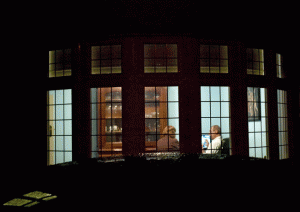 ‘Hi Dad, Go outside after dark and photograph any house with a window you can see someone through’. From: ‘The Dad Directives’ (with Kevin Sykes), Framed inkjet prints and text, 2008.
‘Hi Dad, Go outside after dark and photograph any house with a window you can see someone through’. From: ‘The Dad Directives’ (with Kevin Sykes), Framed inkjet prints and text, 2008.
You are busy with a year-long residency at the University of Bath. This residency takes the idea of collaboration to a whole other level. What does it mean to you, as an artist, to enter the world of academia?
Bath is a research university. It is not an arts university, and there are no arts courses. There is an architecture faulty, closely allied to the engineering department. One of the first things I’ve managed to put into motion is a collaborative project with the architecture faculty. The idea of the Institute of Contemporary Interdisciplinary Arts (ICIA) is, in part, to offer students a cultural experience. Their programme includes gigs, concerts, recitals, theatre productions, and dance; and there are exhibition spaces. When working with artists in residence (like myself) they’ll be able to link the artist to members of faculty in non-arts departments which you might as an artist be fascinated with.
I’ve spent time just walking along the library shelves: title upon title just leaping out at me, almost as an index of the university. It really helped me get my head around the detail and the breadth of what goes on in the university. I figured if there’s a book on a shelf with a particular title, someone there can tell me more about it. So anything from a book on the engineering shelves about how dust distributes itself in different environments to a book on the details of Le Corbusier’s buildings.
I have the luxury of having a year to explore all this stuff and develop work from it. I’ll be doing a number of talks and having conversations with people: varying degrees of public interactions with the university and the people who inhabit it. As an artist I have license to not adhere to the rigorous research processes of the university. I have freedom, in this incredibly rich environment, and I’m discovering new things. I’ve already met numerous people doing fascinating things. This can go somewhere really interesting.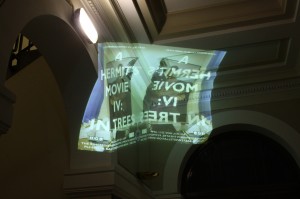 ‘Hermit Movie Rethink’, Planetarium performance lecture adapted for the Old Mine Building, School of Fine Art, University of Leeds, 2013. Photo courtesy COPY & Ned Pooler.
‘Hermit Movie Rethink’, Planetarium performance lecture adapted for the Old Mine Building, School of Fine Art, University of Leeds, 2013. Photo courtesy COPY & Ned Pooler.
You’re interested in hermits at the moment.
I’m reading the Hermit’s Cookbook. It’s all about the early monks and how they became social hermits for the benefit of society and also to illustrate their devotion. I’m taking anyone who’s retreated into architecture or into a certain behaviour as a hermit. Obviously that can accommodate all sorts of things: the studio practice for one.
You begin to explore hermits and architecture in the monologue delivered in the old Planetarium at the University of Plymouth. This is now the ‘Immersive Vision Theatre’.
That was when I started thinking about hermits. That work was about finding fascination in this small concrete planetarium. Even though the door was always open (literally always unlocked) it was quite a hermetic environment. You walk through these big heavy doors into this low, light lobby space, and through more doors into this beautiful dark dome auditorium, with about 40 chairs, and screen and a massive projector humming away in the middle. I started to think about the paradox of retreating into this dome but looking up at ceiling revealing the heavens, and the infinite and the boundaries of the known universe. Literally they had a digital projection that could fly you in real time through the known universe with every planet and star in the exact position it was at that moment. It was based on live data. I wrote a talk based on this technology and lots of other reference points. For me it was the start of realising that, as an artist, I have the freedom to stitch together a lot of different subjects that I think are relevant into a story.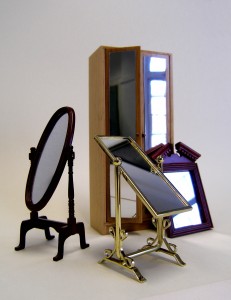 ‘Mirrors From Somewhere Else (#2,3,4,5 for Project Space 11)’, 2001.
‘Mirrors From Somewhere Else (#2,3,4,5 for Project Space 11)’, 2001.
You speak about a relationship between sculpture and performance which is very interesting.
When I’m writing a text, delivering a performance or a talk, I always feel as though its roots are sculptural. That was my training and what led me into this in the first place. Performance feels comfortable to me because in some ways you’re becoming a kind of sculpture. You enter a space and change the atmosphere by your placement. I equate the making of sculpture to the planning of a performance. I’m not saying they are identical but I think about them in a similar way. In the last 2 or 3 years it has been mainly a talking/writing practice. There are sculptural ideas that are now overdue that I now need to start pushing forward.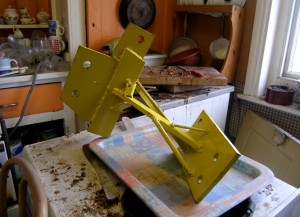 ‘Large Bracket’, Pine, mdf, epoxy resin, hot melt glue and enamel paint, 2008. Made for the exhibition ‘Apartment’, curated by Brian Chalkley and Lewis Amar.
‘Large Bracket’, Pine, mdf, epoxy resin, hot melt glue and enamel paint, 2008. Made for the exhibition ‘Apartment’, curated by Brian Chalkley and Lewis Amar.
‘The Smell of … ‘ brings together so many aspects of your practice (including architecture, space and sculpture). It also explores the the intangible and ephemeral in an intriguing way.
This was a project developed for Tate St Ives. It’s one of a number of projects that I keep going. I haven’t done it again yet. I’m just waiting for the right opportunity. I was again fascinated with the reductive. Often perfumes get given abstract nouns as their names. I’m aware that a heck of a lot of work goes into deciding all this stuff. But obviously in some respects they’re quite absurd. We’re all aware that Calvin Klein ‘Eternity’ is quite ludicrous. But it’s evocative in some way. One of the things I was asked to do for the Late at Tate was to respond to the works on show. This felt like an opportunity to try out an idea of mine: ‘What do we think about when we read the words ‘Obsession’, ‘Knowing’, or ‘Attitude’ (all names of perfumes). These suggested three really interesting ideas about art-making as well.
The perfume bottles were placed on specific points, one in each gallery, down by the skirting boards. Every 20 minutes the invigilators would pick one up and spray (about 5 squirts into the air). I related each of the bottles to the works on show. The Naum Gabo room was filled for a minute or two with ‘Obsession’. So there would be this really repugnant smell. But it fades very quickly. If you’re in the room you see the performative act. If you walk in a second afterwards you get the smell. Maybe 2 minutes after that because of the traffic of people it’s completely dispersed. There’s only a faint hint of it. You might think someone’s just got perfume on. It fades really quickly. I was interested in a funny kind of way in an idea distributing itself as the perfume did. Would you start thinking about Naum Gabo? By association (if you knew ‘Obsession’) would you start thinking about the word ‘Obsession’? Would you start thinking about ‘Obsession’ and Naum Gabo? Should you anyway? At the end of the night, I switched the bottles around. There was quite an arbitrary link anyway. So ‘Obsession’ moved into the room of Margaret Mellis’ work. It was an analytical gesture as well. It might qualify as research but, of course, it’s completely intangible.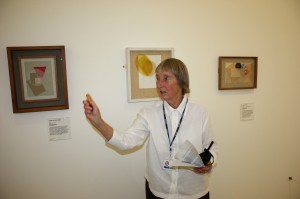 Tate St Ives invigilator enacts ‘The Smell of Knowing’ near works by Margaret Mellis. Solo Late at Tate event, 24th June 2011. Photo: Miguel Amado.
Tate St Ives invigilator enacts ‘The Smell of Knowing’ near works by Margaret Mellis. Solo Late at Tate event, 24th June 2011. Photo: Miguel Amado.
Sound is also something you’ve begun to explore?
I do enjoy stepping into different disciplines. There are plenty I haven’t tried. And plenty I’ve got minimal skill with. Sound is a recent thing that started with the Tate St Ives piece. I really enjoy doing artists talks about my practice, and I consciously make these different every time. I also do the performance-lecture works which are very much artworks in themselves. So for quite a while now I’ve been aware of the talking practice. It was only when I was commissioned to make work for the Late at Tate project that I made my first audio work one of which appears in ‘Leeds Leeds Leeds’. This work is called ‘THEN’: it’s a riff on the NOW albums.
Uncertainty seems to come up a lot in your practice.
I always think an artist should be doing and undoing the same thing. When an artist is making work about something the work should be asserting and undermining something at the same time. That’s what make it interesting, and maybe that’s why it’s art. I’m wary of art that is totally certain of itself.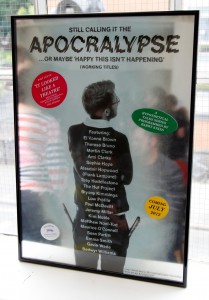 ‘The Apocralypse’, Hypothetical talks project published online, 2012.
‘The Apocralypse’, Hypothetical talks project published online, 2012.
‘Barry Sykes: It must be told’ takes place at Arnolfini (Bristol) Thursday 12 September 2013 to Sunday 15 September 2013, 11:00 to 18:00. For booking see: www.arnolfini.org.uk. The event is £5.
‘Leeds! Leeds! Leeds! at blip blip blip, Leeds closes this Saturday 7 September 2013: www.blipblipblip.co.uk
The Institute of Contemporary Interdisciplinary Arts (ICIA): www.bath.ac.uk/icia/



